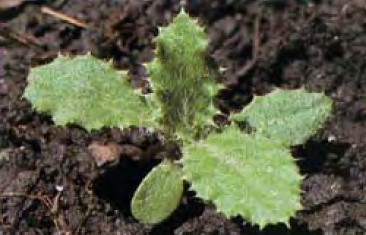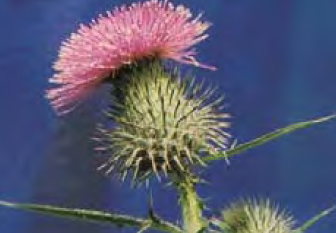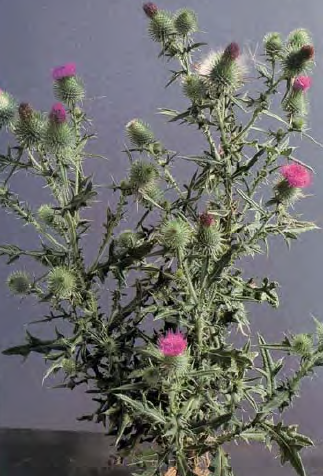Introduction
Bull thistle, also called spear thistle, Fuller’s thistle, and lance-leafed thistle, is a biennial in the sunflower (Asteraceae) family. A native of Eurasia, it is widely established in North America after continuously being introduced as a seed contaminant. Bull thistle has been found in all Nevada counties.
Identification
In the first year of growth, bull thistle (Cirsium vulgare) forms a rosette of leaves (Fig. 1) and develops its short, fleshy taproot. It overwinters as a rosette and then grows erect, spiny-winged stems. The stems grow two to five feet tall and have many spreading branches. They are sparsely hairy.

Figure1.Theyoungleaveshaveafringefringeofspines(left).
The stem leaves are pinnately lobed and three to six inches long. The top of the leaves are prickly and hairy, but the undersides are cottony and woolly. The lobes have stout, needle-like spines at the tips.
The fragrant flowers are one to two inches long and shaped like a gumdrop (Fig. 2). They grow singly at the ends of shoots and branches (Fig. 3) from July through September. They are usually pinkish purple but can be white. The narrow bracts at the base of the flower (involucre) are covered with spines.

Figure 2. Bull thistle flowers are pinkish-purple. The involucre (bracts) is covered with spines (right).
Bull thistle does not reproduce vegetatively, but rather by seed. The light-colored, oblong seeds have dark brown to black longitudinal stripes. They are one-sixteenth inch long and somewhat flattened with white, plume-like hairs (pappus) that readily detach at maturity. A healthy plant produces about 5,000 seeds, but extremely vigorous plants may produce up to 50,000 seeds.

Figure 3. Bull thistle flowers grow at the ends of shoots and branches.
Bull thistle may be mistaken for Canada thistle (Cirsium avense), but there are many ways to tell these plants apart. First, bull thistle is a biennial and Canada thistle is perennial. Unlike bull thistle, the leaves of Canada thistle are not hairy on top and the flower bracts (involucre) do not have spines. In addition, Canada thistle has a rhizomatous root system, while bull thistle has a short taproot that does not creep or spread.
Habitat
In the western United States, bull thistle is the most widespread of the pasture and rangeland thistles. Plants are found in disturbed areas such as roadsides, fence rows, overgrazed pastures and rangeland, eroded gullies, ditch banks, and vacant lots.
Bull thistle grows best on soils that are rich in nitrogen, have a neutral pH, and retain moderate soil moisture. It is rarely found on sand or pure clay soils. It does not grow well in shade or under droughty conditions.
Impact
Bull thistle rapidly colonizes disturbed areas and prospers in pastures that are heavily grazed and receive nitrogen fertilization. The number of rosettes and amount of seed production is significantly higher in grazed pastures compared to ungrazed pastures.
Bull thistle reproduces only by seed. The seeds of bull thistle are easily dispersed by water, animals, human activities, and wind. The most common way large amounts the weed are spread is through transportation of contaminated agricultural products, such as hay. Once established, bull thistle successfully out competes native plant species, depriving them of water and nutrients. Bull thistle’s sharp spines deter livestock and wildlife from grazing them and nearby plants.
Management
Prevention
Since bull thistle reproduces only from seeds, preventing seed production will successfully decrease its spread. Be sure to clean any equipment or vehicles after operating in an infested area. Use clean, certified seed. If a bull thistle plant is found, take action immediately so as to prevent seed production and establishment of a stand.
Mechanical Control
To kill bull thistle till, hoe or hand pull it. Seeds will likely be left in the soil, so revegetate the site with desirable plants that will be able to compete with bull thistle and prevent reinvasion. These methods are most effective when done before bull thistle flowers.
Mowing bull thistle will not eradicate the weed, but it can be used to limit the spread of seed if timed properly. Mow once after the plants produce a flower stalk (bolt) but before they flower, and then again about a month later. Mowing will be more effective if used in combination with other management techniques.
Cultural Control
Re-establishment of desirable vegetation is needed in order to successfully manage bull thistle. Perennial grasses will be the most effective. Good grazing management will encourage grass growth and keep pastures and rangeland healthy. Avoid heavy grazing because it facilitates bull thistle establishment.
Biological Control
The seedhead fly (Urophora stylata) was released in the United States in 1983 and successfully established for biological control of bull thistle in Colorado, Maryland, Washington, California, Montana, and Oregon. It is reportedly providing good control of bull thistle in Oregon, where both are widespread. The larvae feed on developing bull thistle seeds in the flowerheads. The feeding can decrease seed production up to 65 percent.
The weevil, Trichosirocalus horridus, was released on bull thistle in Wyoming, but establishment has not been confirmed.
Chemical Control
When bull thistle plants are in the rosette growth state, clopyralid, dicamba, MCPA, 2,4-D, or picloram can be used in pastures, rangeland, and non-crop areas. Clopyralid should be applied to rosettes in spring or fall at a rate of 0.13 to 0.5 pound active ingredient per acre (ai/A). Applying 0.2 to 0.3 pound ai/A of clopyralid plus one to 1.5 pounds ai/A of 2,4-D will also be effective. Dicamba at a rate of 0.5 to one pound ai/A can be applied to rosettes in the spring or fall, but will only be effective if good growing conditions exist. Applying 1.5 to two pounds ai/A of 2,4-D to rosettes in the spring should provide control. Using only one pound ai/A of 2,4-D while adding 0.5 pound ai/A of dicamba should also be effective. Apply picloram at a rate of 0.13 to 0.25 pound ai/A to rosettes in the spring or fall.
For plants that are in the bolting to bud stages, use metsulfuron or chlorsulfuron. Apply 0.3 ounce ai/A of metsulfuron or 0.75 ounce ai/A of chlorsulfuron. The use of a nonionic surfactant increases the effectiveness of herbicide applications.
References
- Kok, L.T. and A. Gassmann. Bull Thistle – Biological Control of Invasive Plants in the Eastern United States. Invasive Plants of the Eastern United States. 2 Aug. 2004 Bull Thistle (Spear Thistle).
- Sheley, Roger L. and Janet K. Petroff, eds. Biology and Management of Noxious Rangeland Weeds. Corvallis: Oregon State University Press, 1999.
- Whatcom County Noxious Weed Control Board. Bull Thistle. 2 Aug. 2004.
- Whitson, T.D., ed., L.C.Burrill, S.A. Dewey, D.W. Cudney, B.E. Nelson, R.D. Lee, and R. Parker. Weeds of the West. Jackson, Wyoming: Grand Teton Lithography, 2000.
- William, R.D., A.G. Dailey, D. Ball, J. Colquhoun, T.L. Miller, R. Parker, J.P. Yenish, T.W. Miller, D.W. Morishita, P.J.S. Hutchinson, and M. Thompson. 2003 Pacific Northwest Weed Management Handbook. Oregon State University, 2003.
- Photographs are courtesy of Weeds of the West.
Graham, J., Johnson. W., McAdoo, K.
2005,
Identification and Management of Bull Thistle,
Extension | University of Nevada, Reno, FS-05-03


